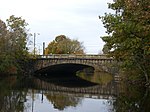House at 60 William Street
Houses completed in 1850Houses on the National Register of Historic Places in Newton, MassachusettsItalianate architecture in MassachusettsNewton, Massachusetts Registered Historic Place stubs

House at 60 William Street is a historic house at 19 Jefferson Street in the Newton Corner village of Newton, Massachusetts. It is listed at 60 William Street in Massachusetts cultural inventory and National Register listings. Built in 1850, it is a well-preserved example of a modest Italianate wood-frame house. It is a 2+1⁄2-story wood-frame building, with an L-shaped layout that has a three-story tower at the crook of the L. Italianate styling includes the tower's shallow-pitch hip roof, and paired round-arch windows on its top level.The house was listed on the National Register of Historic Places in 1986.
Excerpt from the Wikipedia article House at 60 William Street (License: CC BY-SA 3.0, Authors, Images).House at 60 William Street
Williams Street, Newton Newton Corner
Geographical coordinates (GPS) Address Nearby Places Show on map
Geographical coordinates (GPS)
| Latitude | Longitude |
|---|---|
| N 42.359313888889 ° | E -71.182783333333 ° |
Address
Williams Street 54
02172 Newton, Newton Corner
Massachusetts, United States
Open on Google Maps











